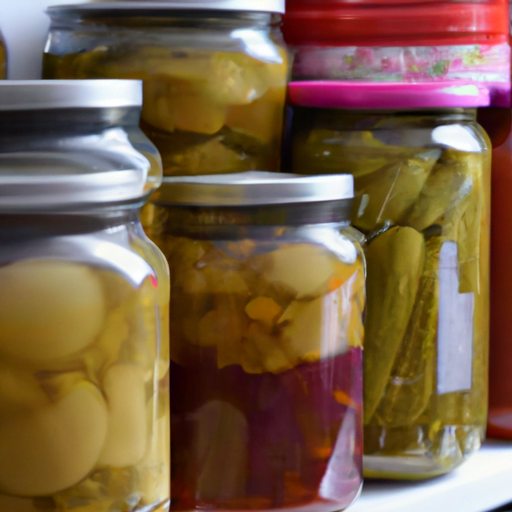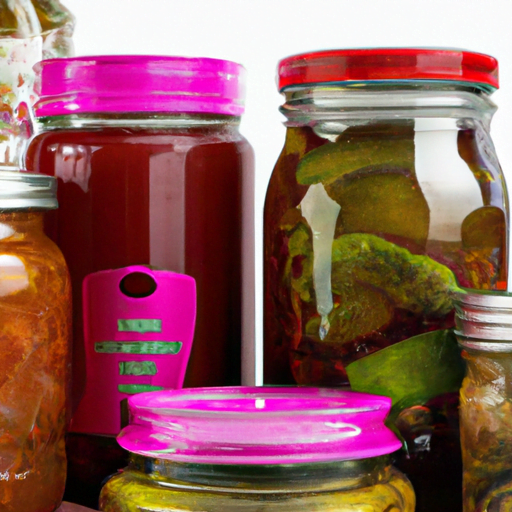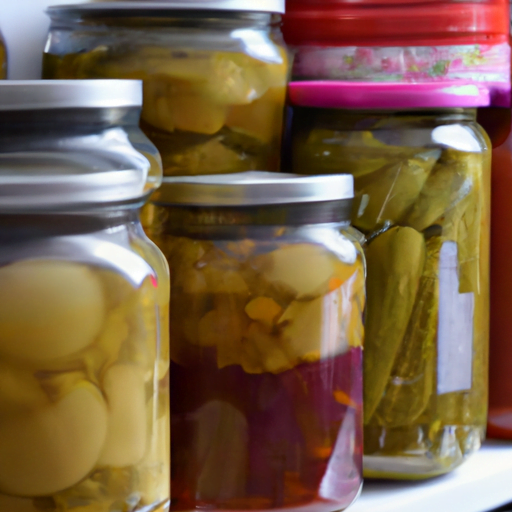So, you’re interested in off-grid living and want to know the essential techniques for food preservation? Well, you’ve come to the right place! When it comes to living off the grid, it’s crucial to know how to preserve your food so you can enjoy it for longer periods of time. In this article, we’ll dive into the basic techniques that will help you make your food last, whether you’re living off the grid or simply want to reduce food waste. Let’s get started!
One of the most popular and effective techniques for food preservation is canning. Canning is the process of sealing food in jars or cans, using heat to kill any bacteria or microorganisms present. This method allows you to store a variety of foods, from fruits and vegetables to soups and meats, for an extended period of time. We’ll explore the step-by-step process of canning in more detail later on.
Another essential technique is dehydrating. Dehydrating your food involves removing the moisture content, which inhibits the growth of bacteria and mold. This method allows you to store foods like fruits, vegetables, and even meat in a compact and lightweight form, perfect for off-grid living or outdoor adventures. We’ll discuss different methods of dehydration and the equipment you’ll need to get started.
Lastly, we’ll cover the art of fermenting, which has been used for centuries to preserve food. Fermentation involves the natural process of converting sugars and starches into alcohol or acids. This not only helps to preserve the food but also enhances its flavor and nutritional value. We’ll explore various fermentation techniques, such as pickling and making sauerkraut, and provide easy-to-follow recipes for you to try at home.
In this article, we’ve only scratched the surface of the essential techniques for food preservation. By learning these methods, you’ll be able to store and enjoy your food for longer periods, whether you’re living off the grid or simply want to reduce food waste. So stay tuned for our in-depth guide on each preservation technique and get ready to become a pro at preserving your food!

Methods of Food Preservation
Food preservation is the process of extending the shelf life of food by applying various techniques to inhibit spoilage and maintain its quality and freshness. There are several methods of food preservation that have been used for centuries, and they continue to be essential techniques for ensuring food safety. In this article, we will explore the methods of canning, freezing, drying, and fermentation, as well as the factors that affect food preservation.
Canning
Canning is a popular method of food preservation that involves sealing food in airtight containers and heating them to destroy microorganisms that can cause spoilage. This method effectively prevents the growth of bacteria, yeasts, and molds. There are two main techniques of canning: water bath canning and pressure canning.
Water Bath Canning
Water bath canning is suitable for preserving high-acid foods such as fruits, jams, and pickles. In this method, jars filled with food are submerged in boiling water and heated to a specific temperature for a specified period of time. The heat kills any microorganisms present, and as the jars cool, a vacuum seal is formed, preventing any air or microorganisms from entering the jar.
Pressure Canning
Pressure canning, on the other hand, is used for low-acid foods such as vegetables, meats, and poultry. These foods require a higher temperature to destroy harmful microorganisms, and pressure canning provides this higher temperature. This method involves using a pressure canner to heat jars filled with food to a specific temperature and pressure for a recommended duration. The increased pressure allows for higher temperatures, ensuring the safety of low-acid foods.
Steps for Canning Process
To can food using either the water bath or pressure canning method, you need to follow these general steps:
- Start by selecting fresh, high-quality ingredients and wash them thoroughly.
- Prepare the canning jars by washing them in hot, soapy water and inspecting them for any chips or cracks.
- Prepare the food by peeling, cutting, and cooking it as necessary.
- Fill the jars with the prepared food, leaving adequate headspace to allow for food expansion during the canning process.
- Wipe the jar rims clean to ensure a proper seal, and place the lids on the jars.
- Process the jars either in a water bath canner or a pressure canner, following the recommended time and temperature guidelines for the specific food being canned.
- After processing, remove the jars from the canner and allow them to cool completely. Check for any signs of spoilage or improper sealing before storing the jars.

Freezing
Freezing is another commonly used technique for food preservation. It is a simple and convenient method that involves lowering the temperature of food to below freezing point, which inhibits the growth of microorganisms and slows down the chemical reactions that cause food to spoil.
How Freezing Preserves Food
When food is frozen, the water inside it turns into ice, forming crystals. These ice crystals effectively immobilize microorganisms, preventing them from causing spoilage. Freezing also slows down the enzymatic activity in food, which helps maintain its quality and nutritional value.
Proper Freezing Techniques
To properly freeze food, follow these guidelines:
- Start with fresh, high-quality ingredients and wash them thoroughly.
- Prepare the food by peeling, cutting, and blanching it if necessary.
- Package the food in airtight containers or freezer bags, removing as much air as possible to prevent freezer burn.
- Label the containers or bags with the contents and the date of freezing.
- Place the containers or bags in the freezer, ensuring they are arranged in a way that allows for proper air circulation.
- Keep the freezer temperature at 0°F (-18°C) or below.
- Avoid thawing and refreezing food, as this can affect its quality and safety.
Storage Tips for Frozen Food
To maintain the quality of frozen food, consider the following tips:
- Use frozen food within recommended storage times to prevent freezer burn.
- Thaw frozen food in the refrigerator or using the defrost setting on a microwave, rather than at room temperature.
- Once thawed, consume the food promptly and do not refreeze it unless it has been cooked.
- When reheating frozen leftovers, ensure they are heated to a safe internal temperature of at least 165°F (74°C).
Drying
Drying, also known as dehydration, is a method of food preservation that involves removing the moisture from food to prevent the growth of bacteria, yeasts, and molds. Drying not only inhibits spoilage but also concentrates the flavors of the food, resulting in a delicious and shelf-stable product.
Air Drying
Air drying is the simplest and oldest method of food drying. It involves exposing food to air and allowing moisture to evaporate naturally. This method is commonly used for herbs, and certain fruits and vegetables such as chili peppers, tomatoes, and mushrooms.
Sun Drying
Sun drying is a traditional method of food preservation that utilizes the sun’s heat and energy to dry food. It is commonly practiced in regions with hot and dry climates. Foods such as fruits, vegetables, herbs, and meat can be sun-dried. However, it is important to ensure proper sanitation and protection from insects during the drying process.
Dehydration Equipment
Dehydration equipment, such as electric dehydrators or ovens, can be used to speed up the drying process and achieve consistent results. These devices provide controlled airflow and temperature to optimize drying efficiency. They are particularly useful for drying foods that require a longer drying time or those that are more prone to spoilage.
Steps for Drying Process
To dry food using either air drying or dehydration equipment, follow these general steps:
- Prepare the food by washing, peeling, and slicing it into uniform pieces.
- Arrange the food in a single layer on drying racks or trays, ensuring proper air circulation.
- Place the food in a well-ventilated area or use a dehydrator or oven set to a low temperature.
- Monitor the drying process regularly, flipping or rearranging the food as needed.
- Depending on the food being dried and the method used, the drying process may take several hours to several days.
- Once the food is completely dry, remove it from the racks or trays and store it in airtight containers or bags in a cool, dry place.
Fermentation
Fermentation is a time-honored method of food preservation that harnesses the natural process of bacteria or yeasts converting sugars into alcohol or acid. This process creates an environment that inhibits the growth of harmful microorganisms and preserves the food. Fermented foods not only have a prolonged shelf life but also offer unique flavors and textures.
Introduction to Fermentation
Fermentation occurs when beneficial microorganisms, such as lactic acid bacteria or yeast, consume the carbohydrates in food and convert them into alcohol, lactic acid, or other organic acids. This process not only preserves the food but also enhances its nutritional value and promotes the growth of probiotics, which are beneficial to gut health.
Benefits of Fermented Food
Consuming fermented foods provides several benefits, including improved digestion, enhanced nutrient absorption, and a boost to the immune system. Fermented foods are also rich in beneficial enzymes and vitamins. Some common examples of fermented foods include sauerkraut, kimchi, yogurt, kefir, and sourdough bread.
Fermentation Equipment
Fermenting food requires minimal equipment, but a few key items can make the process easier and more successful. These include fermentation jars, weights or airlocks to create an anaerobic environment, and a thermometer to monitor temperature. The choice of equipment may depend on the specific food being fermented and personal preference.
Steps for Fermentation Process
To ferment food, follow these general steps:
- Prepare the food by washing, chopping, or shredding it as necessary.
- Add a suitable starter culture or allow the natural microorganisms on the food to initiate fermentation.
- Pack the food into fermentation jars, ensuring it is submerged in its own brine or liquid.
- Place weights or airlocks on the jars to create an anaerobic environment, which is essential for fermentation.
- Maintain the proper temperature and fermentation time according to the specific recipe or guidelines.
- Monitor the fermentation process regularly, checking for any signs of spoilage or off flavors.
- Once the fermentation is complete, transfer the fermented food to storage containers and refrigerate or store in a cool, dark place.
Factors Affecting Food Preservation
There are several factors that can significantly impact the success of food preservation. By understanding these factors, individuals can take appropriate measures to ensure the quality and safety of preserved food.
Temperature
Temperature plays a crucial role in food preservation. High temperatures can accelerate the growth of microorganisms and enzymatic reactions, leading to spoilage. On the other hand, low temperatures help inhibit microbial activity and slow down chemical reactions. It is important to store preserved food at recommended temperatures to maintain its quality and safety.
Humidity
Humidity, or the amount of moisture in the air, can also affect food preservation. Excessive humidity can promote the growth of mold and other spoilage microorganisms, while low humidity can cause foods to dry out or become stale. Different foods have varying humidity requirements, and it is essential to store them at the appropriate humidity levels to maintain their quality.
Microorganisms
Microorganisms, including bacteria, yeasts, and molds, can cause spoilage and deterioration of food. The presence of microorganisms can be controlled through proper food handling and storage practices. It is important to prevent cross-contamination, sanitize equipment and surfaces, and store preserved food in airtight containers to minimize the risk of microbial contamination.
Oxygen
Oxygen can also influence food preservation. Exposure to oxygen can lead to oxidative spoilage, resulting in off flavors, rancidity, and nutrient loss. Proper packaging, such as vacuum-sealed bags or airtight containers, can help protect preserved food from oxygen, ensuring its quality and shelf life.
Conclusion
Essential Techniques for Food Preservation are vital for ensuring food safety and extending shelf life. By using methods like canning, freezing, drying, and fermentation, individuals can conveniently preserve their food. Factors such as temperature, humidity, microorganisms, and oxygen play a significant role in food preservation. Understanding these factors and implementing proper techniques will help maintain the quality and freshness of preserved food. So, whether you are canning your garden harvest, freezing leftover meals, drying herbs, or fermenting vegetables, make sure to follow the recommended guidelines for each method and enjoy the benefits of preserved food for months to come!




